-
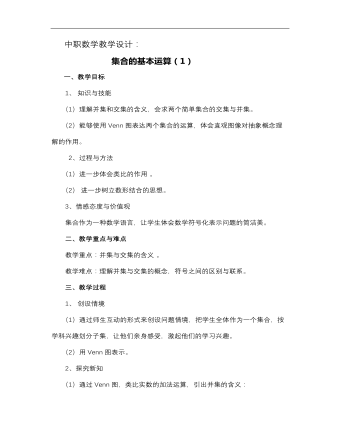
【高教版】中职数学基础模块上册:1.3《集合的运算》优秀教案
集合的基本运算(1) 一、教学目标 1、 知识与技能 (1)理解并集和交集的含义,会求两个简单集合的交集与并集。 (2)能够使用Venn图表达两个集合的运算,体会直观图像对抽象概念理解的作用。 2、过程与方法 (1)进一步体会类比的作用 。 (2) 进一步树立数形结合的思想。 3、情感态度与价值观 集合作为一种数学语言,让学生体会数学符号化表示问题的简洁美。 二、教学重点与难点 教学重点:并集与交集的含义 。 教学难点:理解并集与交集的概念,符号之间的区别与联系。
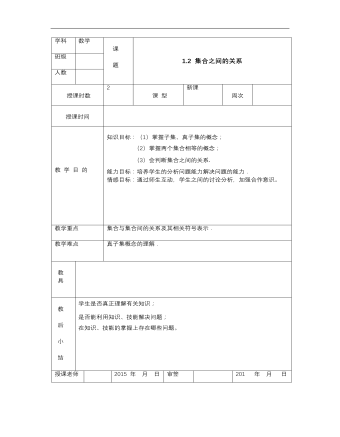
【高教版】中职数学基础模块上册:1.2《集合之间的关系》优秀教案
学科数学 课 题 1.2 集合之间的关系班级 人数 授课时数2 课 型新课 周次 授课时间 教 学 目 的 知识目标:(1)掌握子集、真子集的概念; (2)掌握两个集合相等的概念; (3)会判断集合之间的关系. 能力目标:培养学生的分析问题能力解决问题的能力. 情感目标:通过师生互动,学生之间的讨论分析,加强合作意识。 教学重点集合与集合间的关系及其相关符号表示. 教学难点真子集概念的理解.

【高教版】中职数学基础模块上册:3.1《函数的概念及表示法》优秀教案
课程:数学课题: 3.1.1函数的概念课型:讲授课课时:2课时授课班级:2015级南口班授课时间:2016年3月1日授课地点:南口校区教 学 目 标知识目标1.能用函数语言描述图像、解析式中自变量与函数值的依赖关系; 2.会计算函数的定义域,理解值域的含义 3.会用语言表述自变量与函数值间的对应关系能力目标通过对实例的分析,培养学生的观察能力,抽象概括及逻辑思维能力 通过计算函数的定义域,培养学生的计算能力素养目标函数概念的思想蕴含了很多数学思维,也渗透生活中及其他学科范围内,通过学习使学生认同函数的抽象性。教学重 点理解函数的概念教学难 点判断两个函数是否相同教学方 法引导启发,讲练结合教学资 源演示文稿板 书 设 计3.1函数的概念 设集合A、B为非空数集,对于确定的对 应法则f下,在集合A中取定任意一个数x, 在集合B中都有唯一确定的数f(x)与之相 对应,则称f:A→B为集合A到集合B的一 个函数. 记作:y=f(x),x∈A X叫自变量,y叫函数值,集合A叫函数的 定义域,所有函数值组成的集合叫值域。
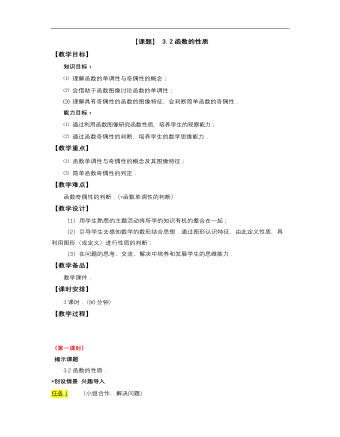
【高教版】中职数学基础模块上册:3.2《函数的性质》优秀教案
【教学目标】知识目标:⑴ 理解函数的单调性与奇偶性的概念;⑵ 会借助于函数图像讨论函数的单调性;⑶理解具有奇偶性的函数的图像特征,会判断简单函数的奇偶性.能力目标:⑴ 通过利用函数图像研究函数性质,培养学生的观察能力;⑵ 通过函数奇偶性的判断,培养学生的数学思维能力.【教学重点】⑴ 函数单调性与奇偶性的概念及其图像特征;⑵ 简单函数奇偶性的判定.【教学难点】函数奇偶性的判断.(*函数单调性的判断)【教学设计】(1)用学生熟悉的主题活动将所学的知识有机的整合在一起;(2)引导学生去感知数学的数形结合思想.通过图形认识特征,由此定义性质,再利用图形(或定义)进行性质的判断;(3)在问题的思考、交流、解决中培养和发展学生的思维能力.【教学备品】教学课件.【课时安排】3课时.(90分钟)【教学过程】
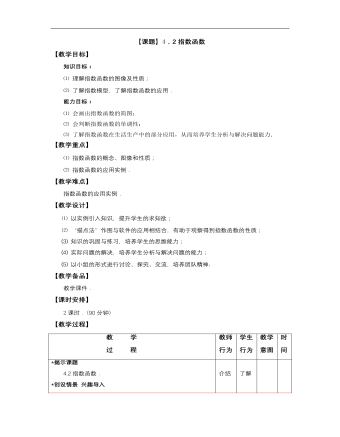
【高教版】中职数学基础模块上册:4.2《指数函数》优秀教案
【教学目标】知识目标:⑴ 理解指数函数的图像及性质;⑵ 了解指数模型,了解指数函数的应用.能力目标:⑴ 会画出指数函数的简图;⑵ 会判断指数函数的单调性;⑶了解指数函数在生活生产中的部分应用,从而培养学生分析与解决问题能力.【教学重点】⑴ 指数函数的概念、图像和性质;⑵ 指数函数的应用实例.【教学难点】指数函数的应用实例.【教学设计】⑴ 以实例引入知识,提升学生的求知欲;⑵ “描点法”作图与软件的应用相结合,有助于观察得到指数函数的性质;⑶知识的巩固与练习,培养学生的思维能力;⑷实际问题的解决,培养学生分析与解决问题的能力;⑸以小组的形式进行讨论、探究、交流,培养团队精神.【教学备品】教学课件.【课时安排】2课时.(90分钟)【教学过程】 教 学 过 程教师 行为学生 行为教学 意图时间 *揭示课题 4.2指数函数. *创设情景 兴趣导入 问题 某种物质的细胞分裂,由1个分裂成2个,2个分裂成4个,4个分裂成8个,……,知道分裂的次数,如何求得细胞的个数呢? 解决 设细胞分裂次得到的细胞个数为,则列表如下: 分裂次数x123…x…细胞个数y2=4=8=…… 由此得到, . 归纳 函数中,指数x为自变量,底2为常数. 介绍 播放 课件 质疑 引导 分析 了解 观看 课件 思考 领悟 导入 实例 比较 易于 学生 想象 归纳 领会 函数 的变 化意 义 5
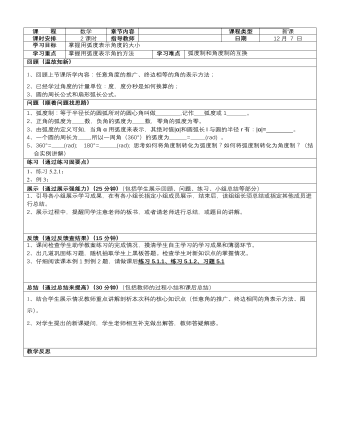
【高教版】中职数学基础模块上册:5.2《弧度制》优秀教案
课 程数学章节内容 课程类型新课课时安排2课时指导教师 日期12月 7 日学习目标掌握用弧度表示角度的大小学习重点掌握用弧度表示角的方法学习难点弧度制和角度制的互换回顾(温故知新)1、回顾上节课所学内容:任意角度的推广、终边相等的角的表示方法; 2、已经学过角度的计量单位:度,度分秒是如何换算的; 3、圆的周长公式和扇形弧长公式。问题(顺着问题找思路)1、弧度制:等于半径长的圆弧所对的圆心角叫做__________,记作____弧度或1________。 2、正角的弧度为_____数,负角的弧度为_____数,零角的弧度为零。 3、由弧度的定义可知,当角α用弧度来表示,其绝对值|α|和圆弧长l与圆的半径r有:|α|=________。 4、一个圆的周长为_____,所以一周角(360°)的弧度为_______=______(rad) 。 5、360°=_____(rad); 180°=_______(rad); 思考如何将角度制转化为弧度制?如何将弧度制转化为角度制?(结合实例讲解)练习(通过练习固要点)1、练习5.2.1; 2、例3;展示(通过展示强能力)(25分钟)(包括学生展示回顾、问题、练习、小组总结等部分)1、引导各小组展示学习成果,在有各小组长指定小组成员展示,结束后,该组组长须总结或指定其他成员进行总结。 2、展示过程中,提醒同学注意老师的板书,或者请老师进行总结,或题目的讲解。
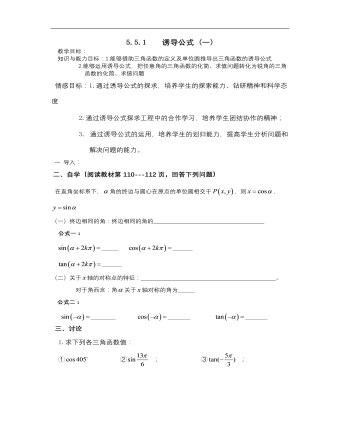
【高教版】中职数学基础模块上册:5.5《诱导公式》优秀教案
教学目标:知识与能力目标:1.能够借助三角函数的定义及单位圆推导出三角函数的诱导公式 2.能够运用诱导公式,把任意角的三角函数的化简、求值问题转化为锐角的三角函数的化简、求值问题情感目标:1.通过诱导公式的探求,培养学生的探索能力、钻研精神和科学态度 2.通过诱导公式探求工程中的合作学习,培养学生团结协作的精神; 3. 通过诱导公式的运用,培养学生的划归能力,提高学生分析问题和解决问题的能力。 一导入:二、自学(阅读教材第110---112页,回答下列问题) 在直角坐标系下,角的终边与圆心在原点的单位圆相交于,则,(一)终边相同的角:终边相同的角的 公式一:_______ ________________(二)关于轴的对称点的特征: 。对于角而言:角关于轴对称的角为_______公式二:__________ _________ _________
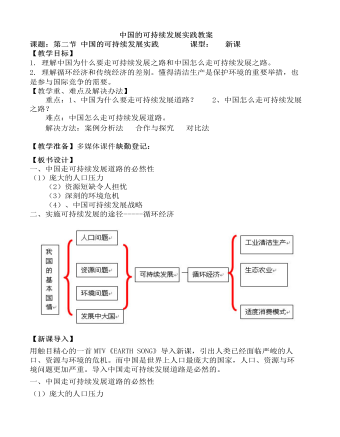
人教版高中地理必修2中国的可持续发展实践教案
1、在工业经济结构调整中,实现循环经济的基本途径是清洁生产让学生分组课前收集乡土地理中清洁生产的案例,将小组收集的案例写成小组作业。让两个小组到课堂上展示,并画出流程图。2、在农业经济结构调整中,我国大力推行生态农业,以实现循环经济留民营村的生态农业按可持续发展的观点,把保护生态环境和发展农村经济有机结合起来 主要措施:(1)调整产业结构:五业并举,全面发展 各业之间相互补充、相互促进、既保持了平衡,又促进了经济的发展 (2)开展综合利用 促进了粮食、牲畜生产的发展,增加了经济效益,降低了污染,净化了环境,有利农民健康,还改变了农田施肥结构,有效地保护了土地资源 (3)广开源流,开发利用新能源 利用太阳能和生物能,节省了以往购煤的开支,还净化了环境 意义和发展方向

人教版高中地理必修3第二章第二节河流的综合开发教案
【课标要求】以某流域为例,分析该流域开发的地理条件。【课标解读】以田纳西河流域为实例,从流域位置、自然环境、自然资源、人口、社会经济基础等方面,分析该流域开发的地理条件。【学习目标】1、读图并结合课文分析田纳西河流域的位置、气候、水文、地貌、自然资源等自然条件。2、阅读课文分析田纳西河流域的人口、社会经济基础等社会经济条件。【教学重点】读图并结合课文分析田纳西河流域的位置、气候、水文、地貌、自然资源等自然条件【教学难点】读图并结合课文分析田纳西河流域的气候、水文条件【教学资源】田纳西河流域的位置图、流域图、 世界气候类型分布图、沿河剖面图、矿产资源分布图
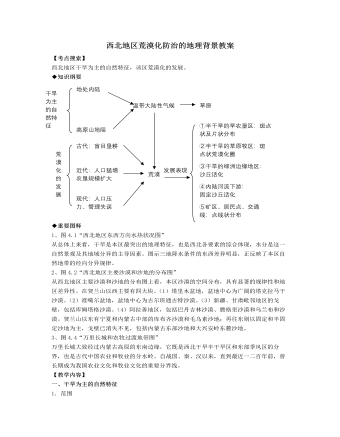
人教版高中地理选修2西北地区荒漠化防治的地理背景教案
【知能训练】一、选择题(第1-4题为单项选择题,第5-6题为双项选择题)1、斑点状土地荒漠化圈主要分布的地方是()A.塔里木河下游绿洲B.呼伦贝尔草原和锡林郭勒草原C.居民点、工矿区及交通线附近D.科尔沁沙地2、近年来,西北地区环境发展的趋势是A.随着人口增加和经济发展,绿洲环境总体趋于好转B.风沙活动增强,盐碱地面积增加C.绿洲经济以农业为主,无环境污染问题D.随着人类对环境影响的加强,绿洲环境向良性方向发展3、我国沙漠沙地所处纬度最高的是()A.科尔沁沙地B.呼伦贝尔沙地C.古尔班通古特沙漠D.乌兰布和沙漠4、我国西北地区干旱为主的自然景观的主要成因是()A.地处北半球亚洲高压的范围之内B.地处东南季风的背风坡C.深居内陆又隔崇山峻岭D.气候干旱、植被稀少、河短水少
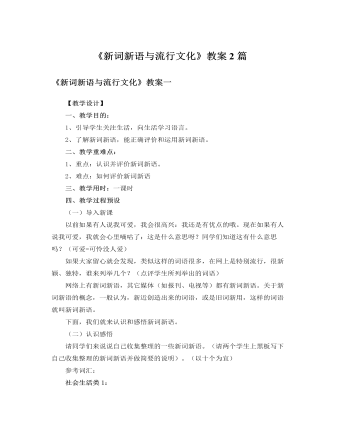
人教版高中语文必修1《新词新语与流行文化》教案2篇
【教学设计】一、教学目的:1、引导学生关注生活,向生活学习语言。2、了解新词新语,能正确评价和运用新词新语。二、教学重难点:1、重点:认识并评价新词新语。2、难点:如何评价新词新语三、教学用时:一课时四、教学过程预设(一)导入新课以前如果有人说我可爱,我会很高兴:我还是有优点的哦。现在如果有人说我可爱,我就会心里嘀咕了:这是什么意思呀?同学们知道这有什么意思吗?(可爱=可怜没人爱)如果大家留心就会发现,类似这样的词语很多,在网上是特别流行,很新颖、独特,谁来列举几个?(点评学生所列举出的词语)网络上有新词新语,其它媒体(如报刊、电视等)都有新词新语。关于新词新语的概念,一般认为,新近创造出来的词语,或是旧词新用,这样的词语就叫新词新语。
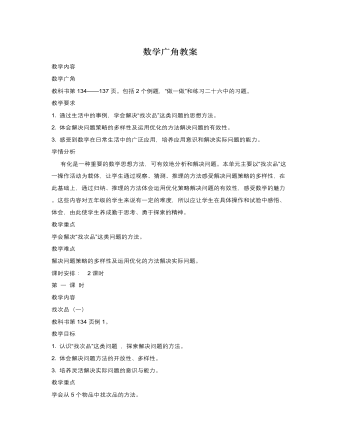
人教版新课标小学数学五年级下册数学广角教案
教学要求1. 通过生活中的事例,学会解决“找次品”这类问题的思想方法。2. 体会解决问题策略的多样性及运用优化的方法解决问题的有效性。3. 感受到数学在日常生活中的广泛应用,培养应用意识和解决实际问题的能力。学情分析有化是一种重要的数学思想方法,可有效地分析和解决问题。本单元主要以“找次品”这一操作活动为载体,让学生通过观察、猜测、推理的方法感受解决问题策略的多样性,在此基础上,通过归纳、推理的方法体会运用优化策略解决问题的有效性,感受数学的魅力。这些内容对五年级的学生来说有一定的难度,所以应让学生在具体操作和试验中感悟、体会,由此使学生养成勤于思考、勇于探索的精神。教学重点学会解决“找次品”这类问题的方法。
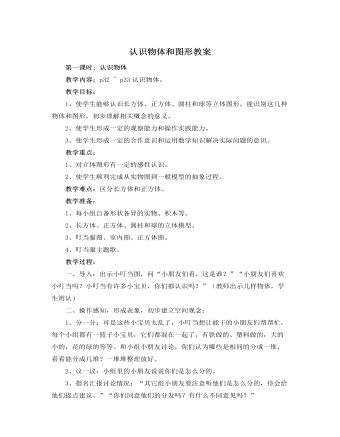
人教版新课标小学数学一年级上册认识物体和图形教案
1.让学生拿出长方体摸一摸,问:你有什么感觉?摸的的面是什么形状?师:谁来摸一摸,老师手上长方体的长方形在哪?(学生找出长方形)2.让学生在自己的学具(长方体、正方体、圆柱体)上找图形,并和小组里的同学说一说。3、指名说,教师把学生找到的图形从立体图形上分离出来,贴于黑板上,师:这些图形是物体上的一个面,这就是我们今天要认识的图形。(板书课题——认识平面图形)4.让学生说说:从什么物体上找到了什么图形?5.师:你能想办法把这些形状画到一张纸上吗?请学生演示各自不同的方法,然后教师在黑板上沿长方体的一个面画出长方形。师:你会画吗?请小朋友们用自己喜欢的办法画出并剪出长方形、正方形、圆和三角形各2个。
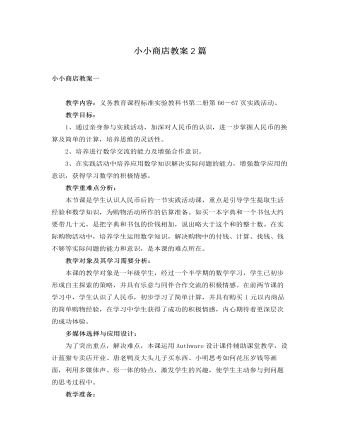
人教版新课标小学数学一年级下册小小商店教案2篇
3、同学们,你们看今天老师带来了什么?(出示一个学生喜欢的玩具)这是昨天老师去商店时买的,猜猜看,这个需要多少钱?(学生猜,教师可提示,最后得出正确标价)今天我们也来开个小小商店玩一玩买卖商品的游戏,想玩吗?4、选营业员及经理。我觉得当营业员最重要的是精通业务,计算能力强。谁想来当?(等学生举手后,教师选出4人。)考虑到我们呆会儿买的人会比较多,每个柜台一个营业员忙不过来,我还准备再选4名商店经理,做好以下几项工作:1)做好接待服务工作,顾客有困难能主动帮助。2)做好买卖过程中的组织工作,让大家有秩序地买商品。3)当营业员计算碰到困难时,两人能商量着解决。觉得自己能做到以上三点的同学可举手参加竞选。(学生举手后,选出4名经理)

人教版新课标小学数学二年级上册表内乘法(一)教案
(6)交流。6的乘法口诀一共有几句?口诀中的第一个数与算式中的第二个因数相同,表示什么?口诀中的第二个数与算式的第一个因数相同,表示什么?相邻两句口诀的积相差几?哪几句难记一些?你用什么方法记呢?怎样记住"三六十八"、"四六二十四"两句口诀?教师在学生发言的基础上鼓励学生大胆说、想出不同记口诀的方法。(7)应用"做一做"第1题(学生半独立完成):①用6根小棒摆1个六边形;②摆2个六边形要用多少根小棒?你是怎样想的?(想口诀"二六十二"。)③运用所学的口诀口答摆4个、6个、3个、5个六边形所需要向小棒数。"做一做"第2题(独立完成):①将第2题改为填空题,在圆圈内填写正确的积;②口答得数,并说一说所用口诀。
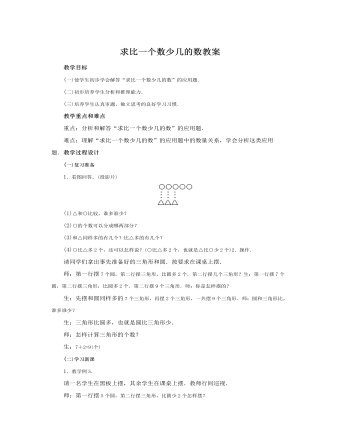
人教版新课标小学数学二年级上册求比一个数少几的数教案
课堂教学设计说明求比一个数少几的数的应用题是低年级教学的一个难点.为了分散难点,在复习准备阶段做了孕伏.如:圆比三角形多2个,也可以说三角形比圆少2个.为了突破难点,让学生动手摆、动口说、动笔写,全方位地调动学生的各种感官参与教学全过程,使学生在参与学习的活动中领悟出“求比一个数少几的数”的应用题仍然是把较大数看作两部分组成的,从大数中去掉大数比小数多的部分,就是小数与大数同样多的部分,也就是小数的数值.也可以通过“假设同样多”去透彻地理解比一个数少几的实际意义.确实使学生理解和掌握了这类应用题用减法计算的道理和解答方法.为了让学生进一步加深理解和掌握“求比一个数少几的数”的应用题的数量关系和解答方法,在巩固练习的最后设计了一组对比题目.
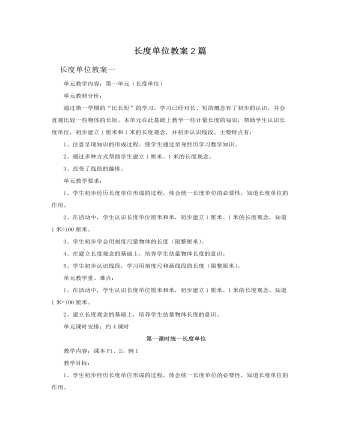
人教版新课标小学数学二年级上册长度单位教案2篇
l尺子上每相邻的两条长刻度线之间的一大格的长度都是1厘米。师:我们大家现在一起用手比划一下,1厘米多长。互相看一下,计住了吗?闭上眼睛想一想,1厘米有多长。3、认识几厘米师:我们现在知道1厘米有多长了,那3厘米又有多长呢?师:同学们还能在尺子上找到其他3厘米的长度吗?4、用厘米量师:刚才上课时,老师展示的2根线绳,到底哪一根长一点呢?现在,同学们先估计一下这两根线绳各自多长,然后在测量比较一下,好吗?师:结果是哪根线绳长一点呢?能说说你是怎么量的吗?三、知识拓展1、师:老师这里有一把尺子,可是它断了一节,没有刻度“0”,只剩下刻度3到刻度10,那么这把尺子能不能用来量物体的长度啊?同学们能不能帮老师想一想办法,好吗?2、其他测量长度的工具(课件展示)

人教版高中语文必修2《成语:中华文化的微缩景观》教案2篇
七、教学反思这堂课有眼下看得见的效果和暂时看不见的长远的效果,学生收益明显:1.学生学到的不只是成语本身。学生从网络上搜集材料,分析整理,不只是学成语,探究能力也得到提高。对成语的梳理探究,是让学生做一件很具体的事——梳理、分析、归类。重在过程,重在课外、课前学生的工作。这样的教学设计很有价值,让学生在活动中得到提高。2.开拓了学生的眼界。学生放眼各种报刊,从报刊中发现问题——大家都可能出错。这样一来学生的眼界变宽了,自信心增强了。3.对成语的理解、运用比过去深刻。让学生从对一个个具体成语的理解入手,进而认识到以后用成语不能犯“望文生义”等错误,从个例上升到一般。4.让学生知道以后自己运用成语应抱什么态度,用什么方法。别人错用成语,是前车之鉴。
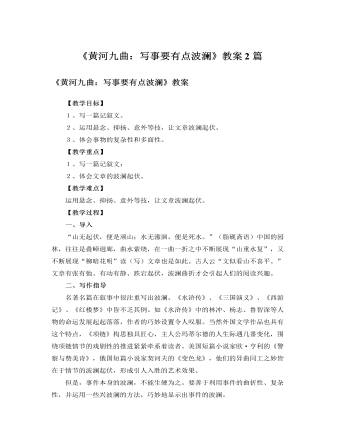
人教版高中语文必修1《黄河九曲:写事要有点波澜》教案2篇
1.悬念法悬念法又称关子。它是作者为了激发那种“紧张与期待的心理活动”,在行文中有意采取的一种积极而有效的手段。这种手段包括“设悬”和“解悬”两方面。所谓 “设悬”就是设置悬念,即在情节发生发展的关键时刻或人物命运攸关的重要关头,叙述戛然而止,转叙他事。从而引起读者强烈的寻根问底的兴趣。所谓“解悬” 也叫“释悬”,就是指在情节发展的特定阶段,通过矛盾的解决,揭示事情原委和人物命运的结局,使读者的期待心理得以满足。如《驿路梨花》,当人们正为露宿而发愁时出现了一间神秘的小屋,小屋的主人是谁呢?猜想间,有人来了,但也不是屋子主人,那小屋子的主人是谁呢?终于知道了小屋是解放军盖的,但为什么要盖这间小屋呢?这样“设悬——释悬——带出新悬念”,环环相扣、层层递进,使文章韵味无穷。
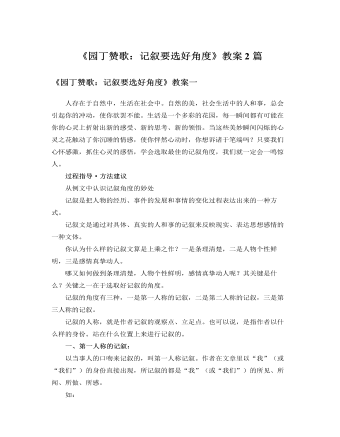
人教版高中语文必修1《园丁赞歌:记叙要选好角度》教案2篇
天上有明月,年年照相思。她夜夜沉醉在梦中。梦把空间缩短了,梦把时间凝固了,梦把世界净化了。梦中没有污秽,没有嘈杂,没有邪恶;梦中没有分离,没有创伤,没有痛苦;梦中只有柔和的月色,只有温馨的爱;梦使她永远年轻,使她不原醒来。…………啊,那个世界,是为天下最真最善最美的心灵准备的,艺术家怀着虔诚的情感,用充满魔力的琴弦,在人们的心中筑起了一座不朽的天堂,它像天地一样长久,日月一样永恒!新月微微地闭着眼睛,她清清楚楚地看到了那座天堂,真真切切地触到了那座天堂,冰凌砌成墙壁,白云铺成房顶,雾霭织成纱幔,星星串成明灯;在那里,她的头发像沐浴之后那样清爽柔软,随风飘拂,她的肌肤像披着月光那样清凉润滑,她的那颗心啊,像浸润着蒙蒙细雨的花蕾,挂着晶莹的露珠,自由地呼吸……她沉醉在那个一尘不染的美好的境界,如歌如诗,如梦如幻,如云如月,如水如烟……





















